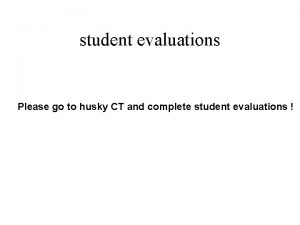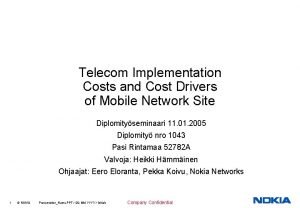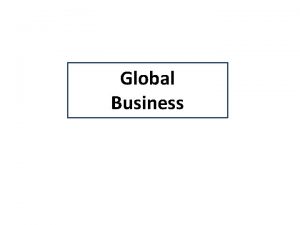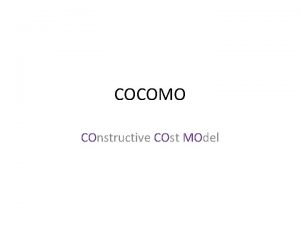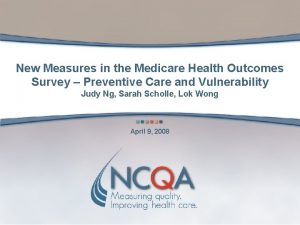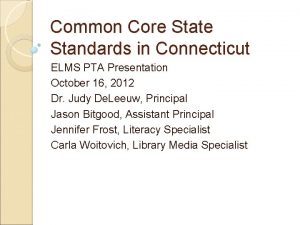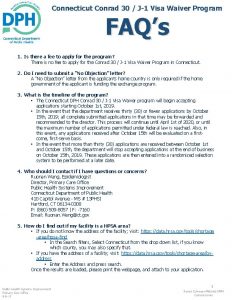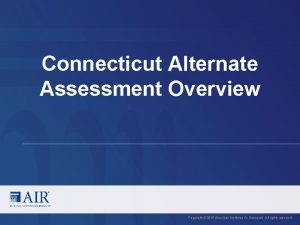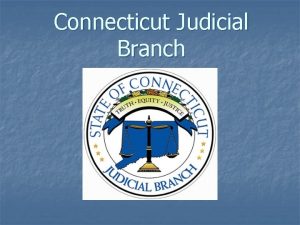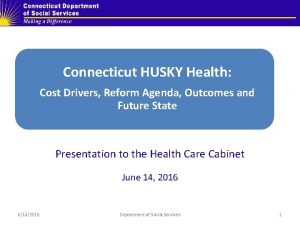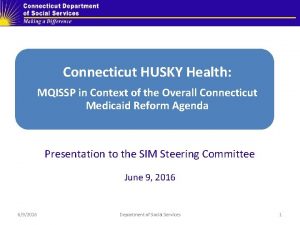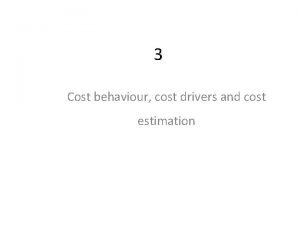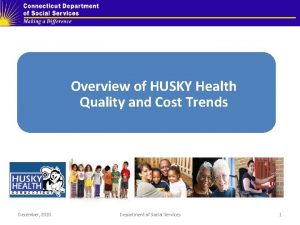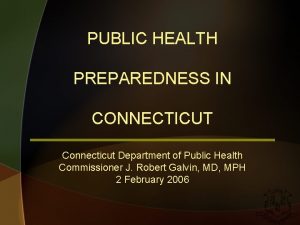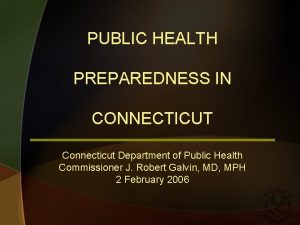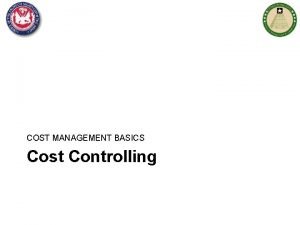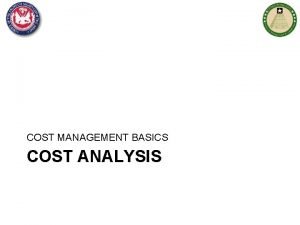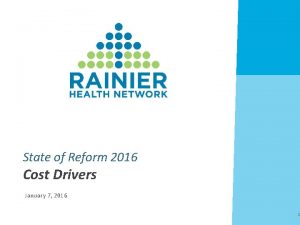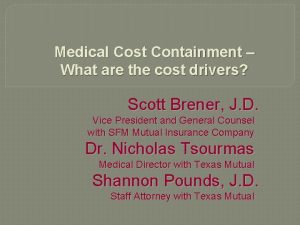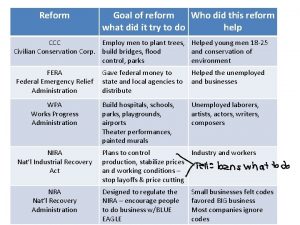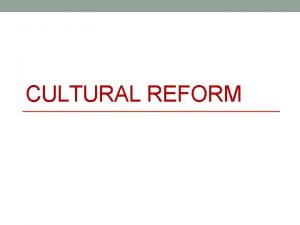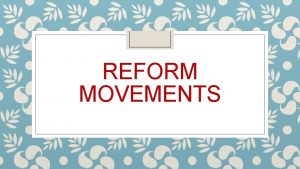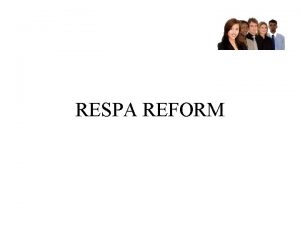Connecticut HUSKY Health Cost Drivers Reform Agenda Outcomes










































- Slides: 42

Connecticut HUSKY Health: Cost Drivers, Reform Agenda, Outcomes and Future State Presentation to the Health Care Cabinet June 14, 2016 6/14/2016 Department of Social Services 1

§ Overview § Cost drivers § Reform agenda § Documented outcomes § Long-term strategies: future state 6/14/2016 Department of Social Services 2

HUSKY Health Overview 6/14/2016 Department of Social Services 3

HUSKY Health at a Glance Critical source of economic security and well-being to over 750, 000 individuals (21% of the population of Connecticut). • Serves adults, working families, their children, their parents and their loved ones with disabilities. • Covers an extensive array of preventative services (primary care through Person-Centered Medical Homes, dental and behavioral health coverage) as well as care coordination. • Successful in improving quality, satisfaction and independence through prevention and integration. Data driven. • Maintains a fully integrated set of claims data for all covered individuals and all covered services. • Uses data analytics to direct policy-making, program development and operations. • Employs predictive modeling to identify both those in present need of care coordination, and those who will need it in the future. Already doing more with less. • Administrative costs are 5. 2%. Total staffing (131 individuals) has held relatively constant while the number of individuals served has dramatically increased. • 59% of Connecticut Medicaid and 88% of CHIP (HUSKY B) expenditures are federally reimbursed. • Health expenditures (70. 7% of department budget) are increasing based on caseload growth, but trends in person costs are stable and quality outcomes have improved. 4

HUSKY Health Financial Snapshot Programs supported: SFY’ 17 proposed program budget: Medicaid, HUSKY B (Children’s Health Insurance Program), long-term services and supports § § SFY 2016 estimated staffing costs: $8. 3 Estimated program federal reimbursement: 59% - Medicaid, 88% - million Administrative cost ratio: 5. 2% HUSKY B (CHIP) Estimated administrative federal reimbursement: 75% for systems, Program outcome highlights: § § Supporting members in accessing primary care and avoiding use of the ED through ICM, PCMH, and comprehensive coverage of behavioral health and dental services Integrating care through initiatives including DMHAS health homes and PCMH practices Rebalancing long-term services and supports Supporting providers through primary care investments, Person-Centered Medical Home initiative, and streamlined administration 6/14/2016 $3. 20 billion (appropriated) $6. 87 billion (total) eligibility, MFP, specialized medical staff; 50% for all other activities Department of Social Services 5

HUSKY Health touches everyone. Children. Working families and individuals. Older adults. People with disabilities. Your neighbor. Your cousin. One in five CT citizens is served by HUSKY Health. 6/14/2016 Department of Social Services 6

HUSKY Health. . . § extends financial security from the catastrophic costs of a serious health condition § enables people to stay well, through prevention, and to work § promotes the health, well-being and school readiness of children § supports independence in the community 6/14/2016 Department of Social Services 7

HUSKY Health is mission-driven. HUSKY Health works in partnership with stakeholders across the health care delivery system to ensure that eligible people in Connecticut receive the supports and services they need to promote self-sufficiency, improved well-being and positive health outcomes. We ensure that the delivery of these services is consistent with federal and state policies. 6/14/2016 Department of Social Services 8

HUSKY Health is person-centered. 6/14/2016 Department of Social Services 9

HUSKY Health is improving outcomes while controlling costs. Health outcomes and care experience are improving. We are enabling independence and choice for people who need long-term services and supports. Provider participation has increased. Enrollment is up, but per member per month costs are stable. The federal share of HUSKY Health costs has increased. 6/14/2016 Department of Social Services 10

HUSKY Health has maximized benefits under the Affordable Care Act. § 100% federal coverage for expansion of Medicaid eligibility (HUSKY D) § coverage of new preventative services including smoking cessation and family planning § new resources for behavioral health integration through DMHASled health homes § $77 million in funding under the State Balancing Incentive Program for home and community-based long-term services and supports (LTSS) 6/14/2016 Department of Social Services 11

Conceptual framework DSS and its state agency partners (DCF, DDS, DMHAS) are motivated and guided by the Centers for Medicare and Medicaid Services (CMS) “Triple Aim”: § improving the patient experience of care (including quality and satisfaction) § improving the health of populations § reducing the per capita cost of health care 6/14/2016 Department of Social Services 12

We are also influenced by a value-based purchasing orientation. The Centers for Medicare and Medicaid Services (CMS) define value-based purchasing as a method that provides for: Linking provider payments to improved performance by health care providers. This form of payment holds health care providers accountable for both the cost and quality of care they provide. It attempts to reduce inappropriate care and to identify and reward the bestperforming providers. 6/14/2016 Department of Social Services 13

Hypotheses We have two critical reform hypotheses: Centralizing management of services for all Medicaid beneficiaries in self-insured, managed fee-for-service arrangements with Administrative Services Organizations, as well as use of predictive modeling tools and data to inform and to target beneficiaries in greatest need of assistance, will yield improved health outcomes and beneficiary experience, and will help to control the rate of increase in Medicaid spending. 6/14/2016 Department of Social Services 14

Building on current preventative and coordinative interventions (e. g. PCMH, ASO-based Intensive Care Management), DMHAS health home) by migrating such efforts to a more community-based approach and building in appropriate value-based payment strategies (e. g. payfor-performance, bundled payments, episodes, shared savings arrangements) will yield further improvements in health outcomes and beneficiary experience, and will continue to control the rate of increase in Medicaid spending. 6/14/2016 Department of Social Services 15

Cost Drivers 6/14/2016 Department of Social Services 16

Key cost drivers for Medicaid include the following: § “high need, high cost” individuals with complex needs § individuals who receive long-term services and supports (LTSS) 6/14/2016 Department of Social Services 17

High Need, High Cost Individuals Using dates of services in CY 2014 and stratifying by child (0 -20) and adult (21 +), the Administrative Services Organizations were asked to provide the department the following information: 1. Highest 10% members by cost, excluding nursing home (NH) residents 2. Highest 10% of members with hospital admission 3. Highest 10 % of members with ED utilization 4. Total unduplicated members from a, b, & c 6/14/2016 Department of Social Services 18

Hospital Inpatient Conditions Adults & Children Total Adults admits: Total Children admits: Infectious/Neoplasms/Nutritional/ Diseases of Blood 1, 459 (20%) 419 (13%) Mental Disorder 1, 413 (19%) 669 (20%) Diseases of Nervous/Circulatory/Genitourinary System 1, 251 (17%) 264 (8%) Diseases of Respiratory/Digestive 1, 627 (22%) Inpatient Conditions 7, 457 3, 315 654 (20%) Pregnancy 100 (1%) 453 (14%) Disease of Skin/Musculoskeletal 351 (5%) 154 (5%) 1, 259 (17%) 702 (21%) Ill defined conditions/Injury & Poisoning 6/14/2016 Department of Social Services 19

Recipients of LTSS Individuals who receive LTSS: § A relatively small number of individuals use LTSS, but their costs are a significant proportion of the Medicaid budget § Individuals who use LTSS typically have high needs and high costs and benefit from coordination of their services and supports § Average per member per month costs are less in the community. 6/14/2016 Department of Social Services 20

100% 750000 $6. 7 B 90% 80% 70% Medical 60% 50% 40% LTC 30% 20% 10% 0% 6/14/2016 LTC Population Department of Social Services Dollars 21

A comparison of average community and institutional costs for individuals at nursing home level of care (2012) Community Nursing Home $0 6/14/2016 $1, 000 $2, 000 Total Cost $3, 000 $4, 000 $5, 000 Medical Costs LTSS Costs Department of Social Services $6, 000 $7, 000 22

Connecticut Medicaid Reform Agenda: Addressing Cost Drivers through Care Coordination, Practice Transformation and New Payment Modalities 6/14/2016 Department of Social Services 23

HUSKY Health’s key means of addressing cost drivers include: Streamlining and optimizing administration of Medicaid through. . . 6/14/2016 • a self-insured, managed fee-forservice structure and contracts with Administrative Services Organizations • unique, cross-departmental collaborations including administration of the Connecticut Behavioral Health Partnership (DSS, DCF, DMHAS) and long-term services and supports (LTSS) rebalancing plan (DSS, DMHAS, DDS, DOH) Department of Social Services 24

Improving access to primary, preventative care through. . . • extensive new investments in primary care (PCMH payments, primary care rate bump, EHR payments) • comprehensive coverage of preventative behavioral health and dental benefits Coordinating and integrating care through. . . • ASO-based Intensive Care Management (ICM) • PCMH practice transformation • DMHAS-led behavioral health homes • Money Follows the Person “housing + supports” approach • Medicaid Quality Improvement and Shared Savings (MQISSP) initiative 6/14/2016 Department of Social Services 25

Re-balancing long-term services and A multi-faceted Governor-led resupports (LTSS) through. . . balancing plan that includes: • Extensive collaboration by DSS, DMHAS, DDS, DOH • State Balancing Incentive Program (BIP) activities • LTSS waivers (DSS, DMHAS, DDS) • Nursing home “right sizing” • Workforce initiatives • My Place consumer portal Moving toward Value-Based Payment approaches through. . . 6/14/2016 • Hospital payment modernization • Pay-for-performance (PCMH, OB) • MQISSP shared savings initiative Department of Social Services 26

Past, Present and Future Past Present Administrative/ financial model A mix of risk-based managed care contracts and central oversight Self-insured, managed fee-for service model; contracts with four Administrative Services Organizations (ASOs) Self-insured, managed feefor-service model that incorporates health neighborhoods and Value. Based Payment (VBP) approaches Financial trends Double digit year-over-year increases were typical Overall expenditures are increasing proportionate to enrollment; per member per month spending is trending down Quality-premised VBP strategies will enable further progress on trends Data Limited encounter data from managed care organizations Fully integrated set of claims data; program employs data analytics to risk stratify and to make policy decisions Data match across human services and corrections data sets will enable more intelligent policy making 6/9/2016 Department of Social Services Future 27

Past Present Future Member experience Members had different experiences depending on which MCO oversaw their services; MCOs relied upon traditional chronic disease management strategies ASOs provide streamlined, statewide access points and Intensive Care Management; PCMH practices enable coordination of primary and specialty care; health homes enable integration of medical, behavioral health and social services Health neighborhoods will address both health needs and social determinants of health (e. g. housing stability) Provider experience varied across MCOs; payment was often slow or incomplete ASOs provide uniform, statewide utilization management and ICM; providers can bill on a bi-weekly basis Consideration of migration to health neighborhood self-management of provider relationships 6/9/2016 Department of Social Services 28

Documented Outcomes 6/9/2016 Department of Social Services 29

HUSKY Health analyses its outcomes through the following means: § § § Use of a broad array of HEDIS and hybrid measures Use of CAHPS and mystery shopper approach Geo-access analyses of provider participation Provider surveys Review of financial trends: overall expenditures and per member per month spend, stratified across all HUSKY Health coverage groups 6/9/2016 Department of Social Services 30

What relevant results do we see in Connecticut, related to our Person-Centered Medical Home initiative? § PCMH practices achieved better results than non. PCMH practices on measures including, but not limited to ambulatory ED visits and asthma ED visits § Immediate access to care increased to 92. 5% of the time, when requested by adults, and 96. 7% of the time, when requested on behalf of children 6/9/2016 Department of Social Services 31

What relevant results do we see in Connecticut, related to our Intensive Care Management (ICM) initiatives? § Over SFY’ 15. Connecticut Medicaid’s medical ASO, CHNCT, has: • for those members who received ICM, reduced emergency department (ED) usage by 22. 72% and reduced inpatient admissions by 43. 87% • for those members who received Intensive Discharge Care Management (IDCM) services, reduced readmission rates by 28. 08% 6/9/2016 Department of Social Services 32

§ Over SFY’ 15, through a range of strategies (Intensive Care Management, behavioral health community care teams) and in cooperation with the Connecticut Hospital Association, the Emergency Department visit rate was reduced by: • 4. 70% for HUSKY A and B • 2. 16% for HUSKY C • 23. 51% for HUSKY D 6/9/2016 Department of Social Services 33

Over SFY’ 15: § Overall admissions per 1, 000 member months (MM) decreased by 13. 2% § Utilization per 1, 000 MM for emergent medical visits decreased by 5. 4% § Utilization per 1, 000 MM for all other hospital outpatient services decreased by 5. 3% 6/9/2016 Department of Social Services 34

Comparison with National Trends * Expenditures are net of drug rebates and include DMHAS' behavioral health costs claimable under Medicaid. This depiction includes all hospital supplemental and retro payments. Department of Social Services 35

* Expenditures are net of drug rebates and include DMHAS' behavioral health costs claimable under Medicaid. This depiction excludes all hospital supplemental and retro payments. Department of Social Services 36

Enrollment and PMPM Quarterly Medicaid Enrollment & PMPM Trends CY 2012 -2015 800, 000 746, 499 754, 469 717, 082 711, 928 700, 000 609, 137 614, 491 587, 758 597, 143 600, 000 621, 337 625, 445 624, 237 731, 908 713, 334 723, 868 $ 1, 000 663, 396 $ 900 583, 515 $ 718 500, 000 400, 000 $ 706 $ 688 $ 711 $ 700 $ 687 $ 684 $ 674 $ 663 $ 700 $ 682 $ 648 $ 646 $ 654 $ 670 $ 669 $ 600 300, 000 $ 500 200, 000 $ 400 100, 000 0 $ 300 Mar-12 Jun-12 Sep-12 Dec-12 Mar-13 Jun-13 Sep-13 Dec-13 Enrollment Mar-14 Jun-14 Sep-14 Dec-14 Mar-15 Jun-15 Sep-15 Dec-15 PMPM Expenditures have increased proportionate to the increase in enrollment, but per member per month costs have remained remarkably steady. Department of Social Services 37 PMPM Enrollment $ 800 $ 730

Long-Term Strategies for Cost Containment: The Future State 6/9/2016 Department of Social Services 38

HUSKY Health 2017 and ongoing Health neighborhoods composed of PCMH practices, specialties, CHWs and non-medical services and supports 6/9/2016 Department of Social Services 39

Development of additional value-based payment strategies MQISSP PCMH enhanced fees and performance payments 6/9/2016 OB P 4 P Shared savings arrangements Department of Social Services Episodes of care 40

Personal Health Record Pre-Screen Assessment Transportation Claims Balancing Incentive Program Person Centered View Care Plan(s) 6/9/2016 Achievement of a personcentered, integrative, rebalanced system of long-term services and supports LTSS Services Financial Eligibility Department of Social Services 41

Key Terms Term Acronym Detail Administrative Services Organization ASO DSS has contracted with four organizations (CHN, Beacon, Benecare and Logisticare) to act as statewide ASOs. The ASOs perform many traditional member support functions , but are also responsible for data analytics and ICM. Behavioral health home BHH DMHAS and DSS have partnered to implement this new means of integrating behavioral health, medical care and social service supports for individuals with Serious & Persistent Mental Illness. Expansion group HUSKY D Connecticut’s Medicaid expansion group includes adults at 18 -64 who are not otherwise eligible for another Medicaid coverage group. Fee for Service FFS A method in which doctors and other health care providers are paid for each service performed. Examples of services include tests and office visits. Intensive Care Management ICM A set of services that help people with complex health care needs to better understand manage their care. Long-term services and supports LTSS Long-term services and supports (LTSS) are a spectrum of health and social services that support elders or people with disabilities who need help with daily living tasks. Medicaid Quality Improvement and Shared Savings Program MQISSP is a Connecticut Medicaid initiative under which DSS will enter into shared savings arrangements with FQHCs and advanced networks. Pay-for-performance P 4 P rewards health care providers for attaining targeted service goals, like meeting health care quality or efficiency standards. Person-Centered Medical Home PCMH is a model for the organization of primary care that ensures effective delivery of the core functions of primary health care. Value-Based Payment VBP links provider payments to improved performance on quality measures. 6/9/2016 Department of Social Services 42
 Husky behavioral health providers
Husky behavioral health providers Choosing the wrong drivers for whole system reform
Choosing the wrong drivers for whole system reform Basic education sector reform agenda (besra)
Basic education sector reform agenda (besra) Public health internships ct
Public health internships ct Ack
Ack Husky air pilot angels
Husky air pilot angels Bprls
Bprls 3/7
3/7 Husky plastic injection molding manufacturer
Husky plastic injection molding manufacturer Heterocromie sectoriala
Heterocromie sectoriala Husky air pilot angels
Husky air pilot angels Agenda sistemica y agenda institucional
Agenda sistemica y agenda institucional Kustannusanalyysi
Kustannusanalyysi Drivers of globalization definition
Drivers of globalization definition Cocomo kloc
Cocomo kloc Medicare health outcomes survey
Medicare health outcomes survey Connecticut compromise
Connecticut compromise Pornography laws connecticut
Pornography laws connecticut Lean manufacturing connecticut
Lean manufacturing connecticut Connecticut college transfer
Connecticut college transfer Connecticut common core state standards
Connecticut common core state standards Connecticut sex offender registry
Connecticut sex offender registry Willimantic ct map
Willimantic ct map Statewide automated victim information notification
Statewide automated victim information notification New haven connecticut
New haven connecticut Connecticut conrad 30
Connecticut conrad 30 Acessament
Acessament Ct mandated reporter training
Ct mandated reporter training P2 plumbing license
P2 plumbing license Boddie v. connecticut
Boddie v. connecticut Connecticut early childhood education cabinet
Connecticut early childhood education cabinet Length of maine coastline
Length of maine coastline Connecticut manufacturing sales tax exemption
Connecticut manufacturing sales tax exemption Connecticut judicial branch
Connecticut judicial branch Ct.gov/sde/cert
Ct.gov/sde/cert Connecticut surplus lines tax
Connecticut surplus lines tax Ct state comptroller
Ct state comptroller Wic approved milk brands
Wic approved milk brands Connecticut judicial districts
Connecticut judicial districts Tcs connecticut
Tcs connecticut John haynes connecticut
John haynes connecticut Started an all-female academy in hartford, connecticut.
Started an all-female academy in hartford, connecticut. Cost accumulation and cost assignment
Cost accumulation and cost assignment




